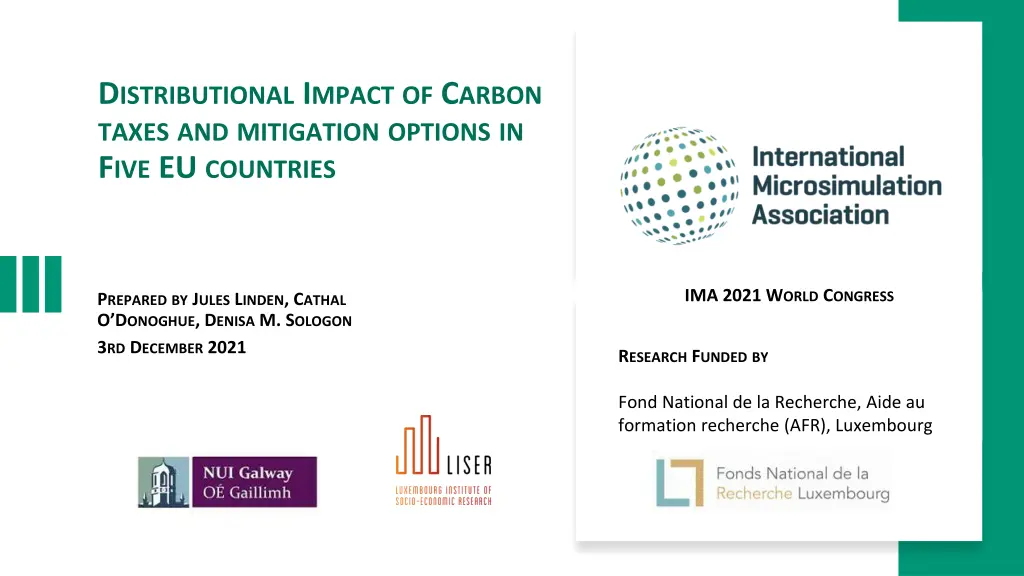
Distributional Impact of Carbon Taxes in EU Countries
Explore the distributional impact of carbon taxes and mitigation options in five EU countries. The research aims to understand the implications of a common carbon tax across Hungary, Portugal, Ireland, Finland, and Luxembourg, with a focus on compensating those negatively affected. Various revenue recycling options and mitigation strategies are discussed based on microsimulation studies and cross-country analyses. The methodology involves a detailed microsimulation model integrating EU-SILC data, input-output models, and linear expenditure systems to assess the impact on disposable income, taxes, and benefits.
Uploaded on | 0 Views
Download Presentation

Please find below an Image/Link to download the presentation.
The content on the website is provided AS IS for your information and personal use only. It may not be sold, licensed, or shared on other websites without obtaining consent from the author. If you encounter any issues during the download, it is possible that the publisher has removed the file from their server.
You are allowed to download the files provided on this website for personal or commercial use, subject to the condition that they are used lawfully. All files are the property of their respective owners.
The content on the website is provided AS IS for your information and personal use only. It may not be sold, licensed, or shared on other websites without obtaining consent from the author.
E N D
Presentation Transcript
DISTRIBUTIONAL IMPACT OF CARBON TAXES AND MITIGATION OPTIONS IN FIVE EU COUNTRIES IMA 2021 WORLD CONGRESS PREPARED BY JULES LINDEN, CATHAL O DONOGHUE, DENISA M. SOLOGON 3RD DECEMBER 2021 RESEARCH FUNDED BY Fond National de la Recherche, Aide au formation recherche (AFR), Luxembourg
CONTEXT: CARBON TAX European Commission s Fit for 55 package extends carbon pricing to transportation and residential sector Carbon tax is a popular tool with governments and economists Efficient, easy to administer, cheap to collect and difficult to avoid ( Metcalf, 2019) Advantage of revenue recycling However they can be unpopular with the population due to distributional issues resulting from taxes on necessities, e.g. home heating and transportation https://taxfoundation.org/carbon-taxes-in-europe-2021/
PURPOSE Understand the distributional impact to better compensate the losers We will compare the distributional impact of a common 15/TCO2 tax across five countries and explore different revenue recycling options Hungary Portugal Ireland Finland Luxembourg
LITERATURE REVIEW Microsimulation studies focus on one country (Berry (2019) in France; O Donoghue (1997), O Malley et al (2020) in Ireland; Andersen and Etkinson (2020) for Sweden; Rausch et al (2011) in the US ; Creedy (2001) in Australia; B chs (2021) in the UK. , Edenhoffer et al (2021) in Germany Generally find regressive impacts of Carbon taxes Cross-country studies Frequently use macroeconomic models (Ekins et al, 2011; Barker and K hler, 1998; Leipprand et al, 2007; Sager et al, 2019) Few microsimulation studies no mitigation strategy or only simple per flat rate transfer because no data on income source or tax payments (Feindt et al, 2021; Flues and Thomas, 2015) Revenue recycling option/Mitigation Strategies Double dividend: reduction of distortionary taxation and improving labour market (Nordhaus, 1993; Bovenberg and Goulder, 1996; Klenert et al 2018; Callan et al, 2009) Redistribution: Universal basic incomes (Berry, 2019), fuel subsidies (Farrell, 2017), increase in social transfers (O Malley, 2020) Socioeconomic characteristics play an important role in determining the carbon tax incidence (Farrell, 2017; Ekins et al, 2011)
Method: Microsimulation model and Data Data EU-SILC HBS Input-Output Model Step 1: Euromod: EU-SILC Total benefits, taxes and disposable income Step 2: Input-Output model CO2 emissions Compute direct and Indirect emissions Step 3: Linear Expenditure System: Household Bugdet Survey Budget elasticities and price elasticities (Cornwell and Creedy, 1995) Step 4: Imputation of Co2 emissions in Euromod data per equivalized disposable income decile and household size Step 5: Simulation of revenue neutral mitigation strategies Consumptio n Model Model Euromod - GHG emission change - Carbon tax payments - Disposable Income - Taxes and Benefits Output Spatial Euromod data with Carbon tax payments Imputation Net Impact of Carbon tax Mitigation Strategies
Carbon Tax incidence
Home Fuel & Electricity Budget Share by Decile 25% Share of Total expenditure (%) DISTRIBUTION OF FUEL EXPENDITURE 20% 15% 10% 5% 0% HU PT IE FI LU Home fuel is a necessity Necessities are relatively more important for poor people Transport luxury good Richer people spend more on transportation fuels Expenditure on Home fuels is larger Transport Fuel Budget Share by Decile 6% Share of Total expenditure (%) 5% 4% 3% 2% 1% 0% HU PT IE FI LU
DISTRIBUTION OF CARBON TAX Carbon Tax as share of household disposable income by Decile 6% Share of Household Disposable Income (in %) 5% 4% Carbon Tax burden largest at the bottom of the distribution More carbon intensive consumption baskets Higher costs in Hungary and Ireland Portugal relatively less polluting consumption basket 3% 2% 1% 0% HU PT IE FI LU
Carbon Emission reduction (in %) 5% 5% 4% % of Pre-tax levels CARBON EMISSION REDUCTIONS 4% 3% 3% 2% 2% 1% 1% 0% HU PT IE FI LU Cost Ratio (CR) 3 relative to change in CO2 emissions Change in disposable income 2.5 2 1.5 1 0.5 0 HU PT IE FI LU
Mitigation Options o General Tax reduction o Payroll reduction o In-work benefit o Universal Basic Income
IMPACT OF CARBON TAX REDUCE GENERAL TAXATION Net Impact of Overall Tax Reduction by Quantile 2% 2% % of Household Disposable Income 1% Overall tax reduction equivalent to no mitigation measure, with revenue absorbed into general taxation Return revenues under the form of tax cut Overcompensates top earners 1% 0% HU PT IE FI LU -1% -1% -2% -2% Global Syste m
IMPACT OF MITIGATION MEASURES REDUCE DISTORTIONS Net Impact of Payroll reduction by Quantile 2% % of Household Disposable Income 1% 0% Double dividend: Payroll reduction Reduces labour market distortions, affect labour demand However net gain at the top, where most employment is Similar pattern across countries HU PT IE FI LU -1% -2% -3% -4% Global Syste m
Net impact of In-work Benefit by Quantile 12% % of Household Disposable Income 10% IMPACT OF MITIGATION MEASURES COMPENSATION AND REDISTRIBUTION 8% 6% 4% 2% 0% HU PT IE FI LU -2% In-Work Benefit Support bottom and middle deciles But, does nothing for non-workers Universal Basic Income Overcompensates bottom deciles Due to Per Capita payment -4% Net impact of Basic income by Quantile 3.5% % of Household disposable income 3.0% 2.5% 2.0% 1.5% 1.0% 0.5% 0.0% Global Syste m HU PT IE FI LU -0.5% -1.0%
IMPACT ON INEQUALITY Change in Gini Coefficient 0.02 Absolute Change in Gini from Pre-tax levels 0.015 Overall tax and payroll reduction increase inequality In-Work Benefit and UBI reduce Gini Coefficients In-Work Benefits exclude the non-earners, but transfers larger amounts to low earners 0.01 0.005 0 HU PT IE FI LU -0.005 -0.01 -0.015 -0.02 CT Tax Payroll IWB UBI Global Syste m
CONCLUSION Distributional Impact: Differences across countries Difference in budget shares of fuel expenditures across countries Differences in price elasticities Mitigation: No one size fits all Hard to achieve both reductions in distortions and to protect losers Mitigation strategies differ in effect across countries, depending on population structure along the income distribution Climate Justice challenges of a common EU carbon tax Not only between EU citizens within countries But between EU countries Research necessary to find country specific solutions!
Thank you Jules.Linden@liser.lu Cathal.odonoghue@nuigalway.ie Denisa.Sologon@liser.lu


